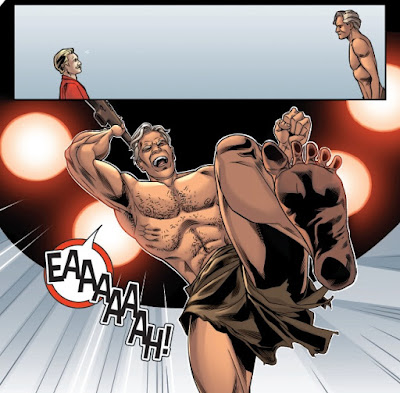When the conceptual splicing of classic "Planet of the Apes" and classic "Star Trek" was first reported, some scoffed and said it would never work. Some even referenced the "Star Trek"/"X-Men" overlaps as proof of why. However, few seemed unnerved when "Apes" and "Alien Nation" merged through Malibu Comics as "Ape Nation" in the early '90s, though perhaps because that crossover seemed wisely suited based on the franchises' commonalities. However, to me, combining the mythic simians with the stalwart Enterprise crew seems simply...well, as Mr. Spock would say, "logical", if not foolishly delayed.
Both "Apes" and "Trek" have acknowledged the existence of alternate dimensions: sometimes speculative; sometimes concrete. "Mirror, Mirror" is the basis for the recent alternate-track "Trek" movies, and the retelling of Caesar and his rise among suppressed simians has folks hungering for the next, revisionist chapter, but oh, how splendid to merge the concepts by returning to where each started.
This is what IDW Publishing/BOOM! Studios has accomplished, placing all five installments of its comic-book saga into one thrilling, alternate-reality volume. And does it work? Heck, it's rather like if we, as kids, had intermingled our Mego action-figures from both sectors and fashioned our own, crossover epic, except that this tale is far more sophisticated than any child could construct, for "the Primate Directive" acts as more than a "Mirror, Mirror" offshoot, by cleverly including those unscrupulous Klingons for melodramatic impact.
The Klingons are led by "Errand of Mercy'"s Commander Kor (played by John Collicos in the series), who has found the means to penetrate inter-dimensional space: i.e., an ape-based parallel Earth. The Klingons wish to arm the evolved simians with specialized rifles, as a stepping stone in implementing Klingon control throughout the newly discovered galaxy.
In the midst of this intrigue, "Primate Directive" not only pays homage to "Errand of Mercy", but adapts an "Enterprise Incident", "Private, Little War" and "Omega Glory" feel, setting sides against each other. This element has always worked for both franchises and exceeds expectations in this merger.
Since the Klingons intend to give the apes greater leverage toward achieving human genocide, Kirk must intervene. However, with dealings between Kor and the militant General Marius (General Ursus's more belligerent counterpart) have already formed, one can only ponder the damage incurred. Fortunately, lost astronaut Colonel George Taylor is there to offer insight (with Charlton Heston's features aptly captured, I might add), as well as gracious Cornelius and Zira.
The script, by Scott and David Tipton, flows naturally. For example, the early phases of the adventure, which center on Sulu and Uhura in Klingon disguises, could have been culled from any classic "Trek" episode (though most likely with Kirk and Spock in those given spots), and the Marius prologue feels not only like something yanked from one of the original "Apes" movies, but even more so the underrated television series. Also, a later-down-the-line, physical confrontation between Kirk and Taylor snaps of historic intensity, with sharp dialogue and fighting action that deftly suits each opponent.
The artwork by Rachel Stott, with vibrant coloring by Charlie Kirchoff, recalls the look and atmosphere of both mythologies, bridging them well with character renderings that flatter the actors who own them.
Above all, the Tiptons' tale nails the best philosophical tones of each series, concentrating on the implications of human interference on an otherwise paved timeline. Few franchises have dealt with this concept as well as these two, and "Primate Directive" succeeds in presenting the pros and cons. In truth, the social ramifications involved hit a new level of depth and insight: quite an accomplishment, considering the quality these series have previously offered.
In less capable hands, this experiment could have devolved into an unintentional parody, but because of its careful construction, we're blessed with a tribute that honors both sources (and fills a number of gaps among the first three "Apes" movies, with one helluva an ending, to boot). Can't recommend it enough and sure hope the concept receives a deserved (and most logical) revisit.









No comments:
Post a Comment